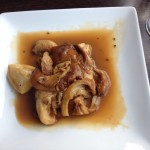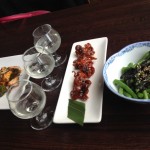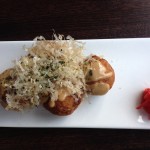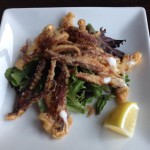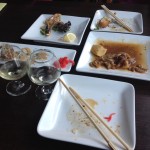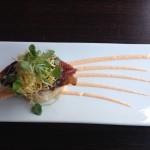
In Japan, an izakaya is basically a tiny little bar with just a few seats. In Chicago, Izakaya Mita, 1960 N. Damen, is a warm yet modern and clean-lined bar and restaurant featuring Japanese cuisine. Japanese-accented easy listening music makes a nice background. Helen Mita, who with chef son Brian opened the place early in 2015, says the goal is to create a comfortable, unpretentious space that offers the best of Japanese comfort food and a full line of versatile and sophisticated alcoholic drinks, including sake (pronounced sah-kay) and shochu (like sake, but distilled rather than brewed). It was a pleasure to be invited to try the place.
If the last time you tasted sake (we Americans used to call it rice wine even though it’s actually brewed like a beer) was in the 70s or early 80s, you’re in for a delightful surprise. Back then, many characterized the flavor as “rotten rice.” But today, the range of flavors and intensities of offerings makes a sophisticated field ripe for investigation—and Izakaya Mita is a perfect place to do your exploring. Helen and her staff are at your service to explain all the choices and give you background on how these food and drink items are made and enjoyed in Japan.
Sake, according to Frank who was our guide/server for the evening, is made by pressing liquid out of rice and then adding some of the rice back into the brew. It’s very clear and has more alcohol than beer or wine, but not as much as hard liquor. Two-ounce pours at Izakaya Mita go for $3.50 to $6 each, five-ouncers for $8 to $13.50, and most varieties that come in the “Sake One-Cup” (6 ounces) for $10-$11. We didn’t get to sample the shochu but look forward to reporting on that next time. The sake wines have poetic names like Chrysanthemum Meadow, Demon Slayer, and Fragrant Jewel.
Frank was incredibly knowledgeable and helpful. He explained that sake wines come in a range–some slightly sweet and others much drier–and he helped us understand what each food item would be like as served. When we ordered the chilled, marinated baby octopus, he warned us about it, saying that many people are shocked to see that these are literally baby octopuses (yes, the correct plural of octopus) served as single bites. We assured him that was okay with us; they were dark reddish, a little chewy and very tasty.
The Piri Kara Kyuri—unpeeled cucumbers—were chunked and served in a spicy, intensely flavorful glaze ($5). Most enjoyable. The Ingen Goma ae—green beans in sweet black sesame—was outstanding ($5). Crisply cooked and nicely accented by a light and thin but mysteriously good sauce. These are a customer favorite, he said.
The sake menu is extensive and varied. For a novice sake drinker like me, Frank suggested a flight of three two-ounce samples and selected two more delicate flavors and one more assertive. They all had layers of floral and other flavors. Later he suggested two more with a little more gumption, and he made excellent choices. One had mushroom-y undertones, and both were richly aromatic and light but fuller-flavored. My companion enjoyed a favorite Asian beer of hers, Asahi, with her meal.
The Ika Geso Kara Age—deep fried squid legs—were crispy and delicious and happily accented with a small tangle of fresh greens ($7). Tokoyaki—octopus balls-sounded irresistible ($7): four half-golf-ball-sized spheres of rice with little chunks of chewy octopus are deep-fried, drizzled with a couple of tablespoons of mayonnaise-based sauce and topped with surprisingly tasty shaved dried fish. Hot and delectable at first bites, a little like rice-based hush puppies. The Kinoko Itame—mushrooms sautéed in buttery soy citrus sauce—made our mouths pucker and smile. What a happy curiosity to taste butter in an Asian-flavored dish; I enjoyed every bite.
The Bincho-Tan grilled items—cooked on a Japanese grill with chemical-free, smokeless, super-hot charcoal made of oak—were offered in one of two ways: either sweet (Taré—Tamari-based teriyaki) or savory (Shio—salt and sake) style. We got shrimp ($5.50) prepared with the sweet approach, and crispy wings ($3) and asparagus ($3.50) made with the salt and sake approach. The shrimp came three small to a brochette, nicely cooked—though missing conspicuous grill marks—with a much lighter flavor than some of the other dishes. The wings were tasty, though not particularly crisp (we were there when the restaurant first opened, so it may be the grill hadn’t reached its full-scale charring stage), and the asparagus was crisply cooked and good. Happily, none of the dishes tasted overly salty, as has been known to happen with Asian sauces.
We made room for one more dish, an Unagi rice slider—broiled eel with eel sauce, brushed with egg and sugar and served on a dense, compact inch-square rice patty ($6). Greatly enjoyed the rich eel flavors. By this time, the two of us were full, but there is a whole array of other menu items to choose from including various tempura ($3 to $6.50), hearty bites such as sirloin, pork, fish, etc. ($6.50 to $14.50), and noodle dishes featuring mixed seafood, pork, vegetables, chicken, etc. ($13.50 each).

